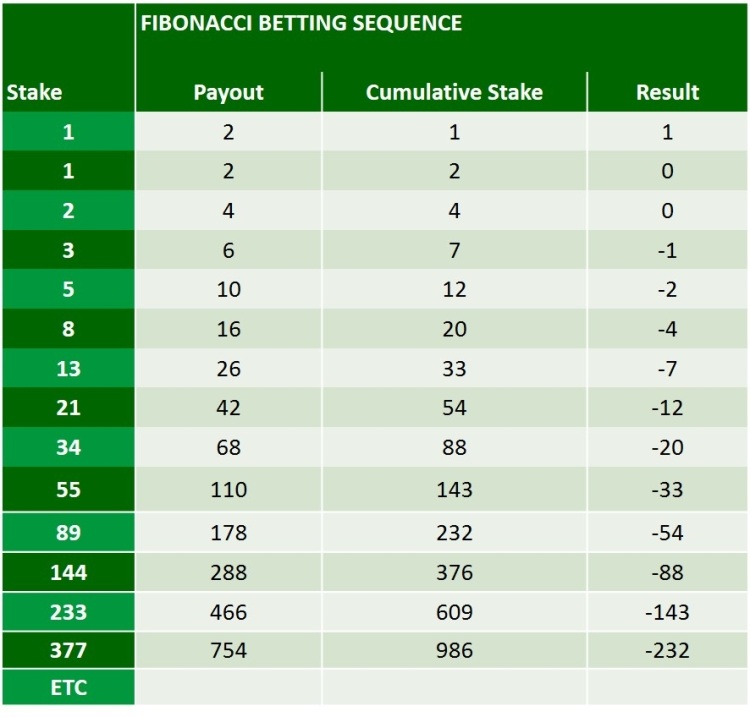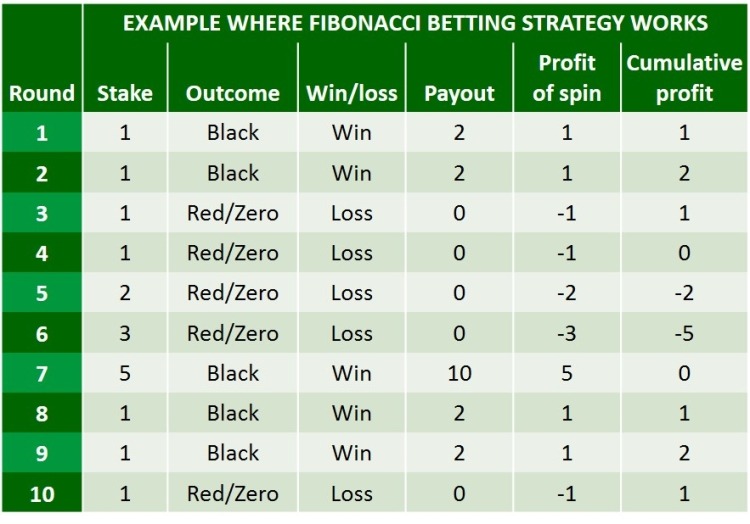The Fibonacci strategy has its origin from the famous Fibonacci sequence. You probably have seen it at school.
In this sequence, every next number is the sum of the two previous numbers in the series. It applies for ‘even’ bets, so betting on Red-Black, Odd-Even or 1-18/19-36 at roulette or betting Punto or Banco at baccarat.
In the Fibonacci strategy, the sequence is as follows:
1-1-2-3-5-8-13-21-34-55-89-144-233-377-610-987-….
The numbers of the sequence represent the amount you should bet. If you lose a bet, you follow the series and increase your next stake according to the sequence, until you manage to win a bet.
Once, you have won your bet, you start at the beginning again, with 1 unit (for example $1).
The table below summarises how the Fibonacci strategy works.

The strategy looks very promising, at first glance.
Unfortunately, it does not give you any guarantees. It is just a sequence of numbers telling you how much to bet. It does not change the odds of you winning a game.
If you lose 8 or more times in a row, your losses become more significant. You need to make up winning many times on your first spin, to get your profits back to the desired level.
An example of a winning Fibonacci strategy
Example 1: Here you see when the Fibonacci strategy is beneficial.
You always bet on Black. You start with one unit (which could be $1).
- You win the 1st and the 2nd
- The 3rd round, you lose. You follow the Fibonacci sequence. You lose again and continue with the sequence and stake 1 units in round 4.
- You lost round 4, and in round 5, you continue the sequence and stake 2 units.
- You also lost round 5, and in round 6, you stake 3 units.
- You also lost round 6, and in round 7, you stake 5 units.
- You win round 7, and in round 8 you start the sequence again with one unit.
- You win round 8, and in round 9 you start again with 1 unit. You win round 9.
- In round 10 you start again with 1 unit. You lose round 10.

Here, you end up with a profit of 1 unit (a $1 profit) after 10 spins, even though the number of your wins (5 times Black) exactly match your number of losses (also 5 times Red or Zero).
The Fibonacci strategy is less progressive and less risky than the Martingale Strategy, as the increments of the sequence are less aggressive.
In Martingale the steps are doubled each time (1->2->4->8->16->32 etc.). The sequence is steep (large increments). The steps in the Fibonacci sequence are not as steep (1->1->2->3->5->8->13 etc).
An example where the Fibonacci strategy fails
Example 2: Here you see when the Fibonacci strategy does not work.
You always bet on Black and start with one unit (which could be $1).
- You win the 1st and the 2nd
- The 3rd round, you lose. You follow the Fibonacci sequence. You lose again and continue with the sequence and stake 1 units in round 4.
- You lost round 4, and in round 5, you continue the sequence and stake 2 units.
- You also lost round 5, and in round 6, you stake 3 units.
- You also lost round 6, and in round 7, you stake 5 units.
- You also lost round 7, and in round 8, you stake 8 units.
- You also lost round 8, and in round 9, you stake 13 units.
- You also lost round 9, and in round 10, you stake 21 units.
- You lose round 10.

The bad news: With the Fibonacci strategy, you end up with significant losses if you have a long losing streak.
In this example, the losses amount to 52 units ($52) after 8 consecutive losses.
The Fibonacci Roulette strategy is less aggressive than the Martingale strategy.
The good news is that the Fibonacci strategy is less risky roulette strategy than the Martingale strategy. With the Martingale strategy, you would have ended up with a loss of 253 units (compared to the 52 units with the Fibonacci Strategy).

